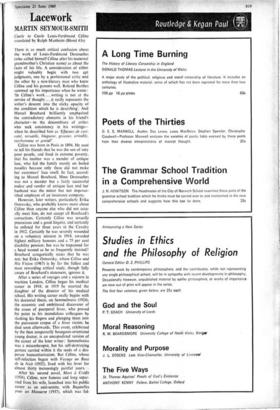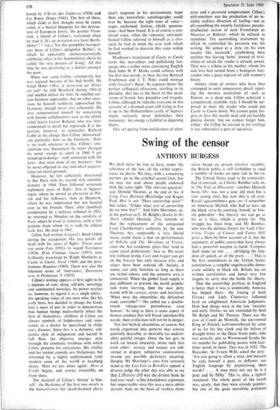Lacework
MARTIN SEYMOUR-SMITH
There is as much critical confusion about the work of Louis-Ferdinand Destouches (who called himself aline after his maternal grandmother's Christian name) as about the facts of his life. A consideration of either might valuably begin with two apt judgments, one by a professional critic and the other by a non-literary man who knew Celine and his parents well. Roland Barthes summed up his importance when he wrote: 'In aline's work ... writing is not at the service of thought ...it really represents the writer's descent into the sticky opacity of the condition which he is describing'. And Marcel Brochard brilliantly emphasised the contradictory elements in his friend's character—to the discomfiture of critics who seek consistency in his writings— when he described him as Effarant de curi- °site, versatile, blagueur, grossier, irritable, mythomane et genial!'
Celine was born in Paris in 1894. He used to tell his friends that he was the son of very poor people, and lived in extreme poverty; that his mother was a mender of antique lace, who fed the family mostly on boiled noodles because only these did not make her customers' lace smell. In fact, accord- ing to Marcel Brochard, Mme Destouches was not a mender but a fairly successful maker and vendor of antique lace and her husband was the minor but not impover- ished employee of an insurance company.
However, later writers, particularly Erika Ostrovsky, who probably knows more about Cline than anyone else who did not actu- ally meet him, do not accept all Brochard's corrections. Certainly Celine was sexually precocious and a good linguist, and certainly he enlisted for three years in the Cavalry in 1912. Certainly he was severely wounded on a voluntary mission in 1914, awarded highest military honours and a 75 per cent disability pension; but was he trepanned for a head wound as he so frequently insisted? Brochard categorically states that he was not; but Erika Ostrovsky, whose Celine and His Vision (1967) is by far the fullest and most rewarding critical study, though fully aware of Brochard's statement, ignores it.
After a series of voyages and a sojourn in wartime London, Celine began his medical career in 1918; in 1919 he married the daughter of the director of his medical school. His writing career really begins with his doctorial thesis, on Semmelweiss (1924), the eccentric and embittered discoverer of the cause of puerperal fever, who proved his point to his incredulous colleagues by slashing his fingers and plunging them into the putrescent corpse of a fever victim; he died soon afterwards. This event, celebrated by the then temporarily bourgeois-orientated young doctor, is an encapsulated version of the career of the later writer: Semmelweiss was a misanthropist, but his self-destroying gesture carried within it the seeds of a des- perate humanitarianism. But Celine, whose self-infection began with Voyage au Bout de la Nuit (1932), lived with his fever for almost thirty increasingly painful years.
After his second novel, mart a Credit (1936), aline, now famous and long separ- ated from his wife, launched into his public career as an anti-semite, with Bagatelles pour un Massacre (1937), which was fol- When war came Celine volunteered, but was rejected because of his bad health. He hated Hitler ('Moi, je prouverai qu' Hitler est jug!' he told Brochard during 1941-2) and smelled defeat for him; he repelled cer- tain German approaches, but on other occa- sions he himself recklessly approached the Germans, though never very coherently. He also compromised himself by associating with known collaborators such as the (then) rabid fascist Lucien Rebatet, who was later condemned to death but reprieved. It is im- portant, however, to contradict Richard Cobb in his charge that Celine 'denounced' any particular Jews to the Germans: there is no truth whatever in this. Celine's anti- semitism was theoretical; he never changed his mind—except to admit in 1960 'I got mixed up in doings—stuff connected with the Jews—that were none of my business'—but he never objected to any individual acquain- tance on racial grounds.
However, he felt sufficiently threatened to flee Paris with his second wife (another dancer), in 1944. Then followed seventeen nightmare years of flight: first at Sigmar- ingen, where he served as physician to Pet- ain and his followers, then in Denmark, where he was imprisoned but not handed over to the French. Then, after (justified) exoneration by a military tribunal in 1951, he returned to Meudon on the outskirts of Paris where he lived in isolation, with a few patients from whom (it is said) he seldom took fees. He died in 1961.
Celine had written Guignol's Band (1944) during the occupation. His last novels all dealt with his years of flight: Feerie pour une autre Fois (1951), its sequel Normance (1954), D'un Chateau l'autre (1957), now brilliantly translated by Ralph Manheim as Castle to Castle, Nord (1960) and the post- humous Rigadon (1969). There was also the hilarious series of 'interviews', Entr•etiens avec le Professeur Y (1955).
Caine's writing appears at first sight to be a mixture of rant, slang, self-pity, scatology and sentimental nostalgia. Its power teaches us, however, to regard it as a single entity: the speaking voice of one man who, like his early hero, has decided to plunge his hands into a mass of pus in order to demonstrate that human beings malevolently infect the best of themselves: children in Celine are always symbols of helplessness and inno- cence; as a doctor he specialised in child- ren's diseases. Since this is a dynamic, sub- jective style of indignation and hatred in full flow, the objective emerges only through the cinematic vividness with which Celine presents his caricatures. His vitality and his violent comedy are Dickensian, but informed by a highly sophisticated, truly modern sense of the world in headlong decay. 'Here we are, alone again', Mort a Credit begins, and carries irresistibly on from there.
The material of Celine's 'fiction' is him- self: the Bardamu of the first two novels is the humanitarian but death-haunted physi- lowed by L'Ecole des Cadavres (1938) and Les Beaux Draps (1941). The first of these, which Gide at first thought must be comic satire, is a bestial blueprint for the destruc- tion of European Jewry; the painter Vlam- inck, a friend of Caine's, exclaimed when he read it, 'It's an invitation to a Saint Barth- elemy! ! !' (sic.). Yet this pamphlet incorpor- ates three of Caine's delightful 'Ballets', in which he apparently uncharacteristically celebrates what in his Semmelweiss thesis he called 'the very process of living'. All this time he was practising as a doctor amongst the poor.
cian's response to his environment, truer than any naturalistic autobiography could ever be, because the right tone of voice— eager, enchanted, furious, ribald, spontan- eous—had been found. It is of course a con- trived voice; when the romantic, anti-intel- lectual Celine referred to himself as a clas- sicist he had in mind the care with which he had worked to discover this voice within himself.
Manheim's translation of Castle to Castle turns this marvellous and pullulating lan- guage into a rather more convincing English than John H. P. Marks could achieve with the first two novels, or than the late Bernard Frechtman and J. T. Niles could manage with Guignol's Band: he captures better the perfect colloquial relaxation, startling in its placidity, that lies at the heart of this mael- strom of hatred, fun, prejudice and tragedy. Caine, although he ridicules everyone in this account of a doomed court still trying to live it up in the Hohenzollern castle of Sigmar- ingen, curiously never diminishes their humanity: his energy is faithful in depicting theirs.
This art sprang from recklessness of char-
acter and a paranoid temperament. Caine's anti-semitism was the production of an in- itially reckless direction of feeling—not at all resembling the meanly fastidious, pseudo- intellectual racism of such Frenchmen as Maurras or Rebatet—which he refused to repudiate. The astonishing instrument by which he controlled his paranoia was his writing. He aimed at a style (in his own words) 'like lacework', establishing bare outlines but leaving 'holes' instead of trivi- alities of which the reader is already aware. That was a tribute to his mother, whom his sick love had turned from a bourgeois lace- vendor into a poor repairer of rich women's finery.
Almost alone of writers who have thus attempted to omit unnecessary detail, reject- ing the massive naturalism of such as Dreiser as a dead end, Celine achieved a compulsively readable style. I should be sur- prised to meet the reader who could put Castle to Castle down. We cannot quite for- give or love this nearly mad and yet harshly precise doctor, but we cannot forget him, either: the Celine he created in his writings is too substantial a part of ourselves.







































 Previous page
Previous page